Spaces of Dependence and Emancipation in Architectural and Urban Narration, a Case Study: Plac Żołnierza Polskiego and Plac Solidarności in Szczecin
Abstract
1. Introduction
2. Materials and Methods
3. Spaces of Dependence and Emancipation: A Case Study
3.1. Space—Background
- Physical space: space in architecture–urban space; public space–private space; cultural space.In this category, space can be defined as a material and physical structure.According to the dictionary definition, urban space “refers to several urban areas and their related multicentric municipalities forming a whole in a single stretch.” (Definition quoted from the National Institute of Statistics and Economic Studies, which ‘collects, analyzes and disseminates information on the French economy and society’: https://www.insee.fr/en/metadonnees/definition/c1074 (accessed on 8 February 2021).) One of the many definitions of space in architecture (Üngür 2011) characterizes it as “organised and shaped in real forms necessary to satisfy material and spiritual human needs” (Niezabitowska 2006). Another definition connects space with sociological areas, and describes it as the interior and exterior space of a building, formed as a result of spatial relationships with other buildings and social relationships (Goss 1988; Hillier and Hanson 1984; Tuan 1983).In terms of morphology, public space is “a place accessible to all citizens, for their use and enjoyment” (Jackson 1985). Private place “is open to those permitted by law or custom” (Birch 2007, p. 118; Francis 1989). Cultural space is:“a special type of public space, characterised by the presence of cultural heritage values or contemporary cultural goods, and by existing or potential opportunities for the creation of cultural functions. These may be complexes of buildings, urban interiors or a series of streets.” (Pazder 2008, p. 21)
- Political space: socialist city space–post-socialist city space; dependency space–post-dependency space.Space classified in this way is determined by the political situation, which is a factor influencing the physical space; we thus define the space of a socialist city as an urban area which, as a result of the political and economic transformation of the 1990s, is subject to the process of freeing itself from the features of a socialist city (Grabkowska 2017). (Definition quoted from the glossary of terms of socioeconomic geography (available online): http://www.edupedia.pl/words/index/show/292003_slownik_pojec_geografia_spolecznoekonomycznej-miasto_postsocjalistyczne.html (accessed on 8 February 2021)). With regard to the space of dependence, this term should be interpreted as a political state of the territory’s dependence (as in the case study discussed above, concerning the Soviet Union), as opposed to post-dependence understood as freeing oneself from a political hegemon (Praczyk 2015).
- Social space: colonial space–post-colonial space; dependency space–post-dependency space; dependency space–emancipation space; space of production–space of consumption–space of symbolism–space of exchange.In Polish scientific discourse, the colonial and post-colonial space is identified with the space of dependence and post-dependence (Praczyk 2015; Kołodziejczyk 2013; Nycz 2011; Kołodziejczyk 2011; Bakuła 2011). However, there are differences between these concepts. Colonizers and colonized function together in space, creating complex mutual relations and dividing it among themselves in various ways (Praczyk 2015, p. 124; Kotkin 2005, pp. 126–36; Hannertz 2006, pp. 141–92) while the space of dependency, read in political terms, is not shared physically with the colonizer. The research tools used by post-colonial studies (categories: difference, inferiority and taming) have successfully been applied to Polish realities, enabling the nuanced specificity of the space of dependency to be extracted (Praczyk 2015). The very term ‘post-dependency’ was defined by Ryszard Nycz in 2011 as part of the ‘Polish post-dependency discourse’, understood as a set of: “significant, institutionalised practices of articulation–organising human experience, identity projects, social, political and cultural relations, an axiological and symbolic community imaginarium, forms of perceiving reality–which were undertaken after the dependency had ceased, while at the same time showing traces of it almost de rigeur.” (Nycz 2011, p. 8) The process of emancipation initiated before the dependency constitute the space of dependence as “a closed space of supervision, subordination and incapacitation"; and the space of emancipation, in opposition to it, as “an open space of choice, self-creation, inventive action” (Nycz 2011, p. 8).To understand the historical, social and spatial condition of space, dependence and emancipation, one should cite the theoretical context based on the interpretation of Lefebvre’s production of space theory (Lefebvre [1974] 1991), developed by Harvey (2012) and Soja (1996). Lefebvre defined it thus: “(Social) space is a (social) product ... the space thus produced also serves as a tool of thought and of action ... in addition to being a means of production it is also a means of control, and hence of domination, of power” (Lefebvre [1974] 1991, p. 26), forming his theory in the triad: spatial practice, representations of Space, space of representation. Lefebvre also proposed a new way of thinking about the city, urban strategies and social practices, describing it as ‘the right to the city’. Within the proclaimed manifesto, he distinguished the basic theoretical concepts: structure, function and form (Lefebvre 1996). Jałowiecki also refers to the social production of space, characterizing the following elements of social space: forms–an area with a specific purpose and function, with the accompanying material tools and equipment (space: production, consumption, power, symbolism and exchange); determinants–the conditions for the production of space (universal barriers, development of techniques and technologies, relations of subordination, values and categories of culture); and actors–persons producing space according to their interests, ideology and needs (Jałowiecki [1988] 2010, pp. 37–50).
3.2. Spatial Structure
3.2.1. Urban and Formal-Semiotic Components
- Plac Żołnierza Polskiego in Szczecin
- Plac Solidarności in Szczecin
3.2.2. Features of the Spatial Structure
3.3. Reading the Spaces of Dependence and Emancipation
3.3.1. Baroque Architecture as a Tool of Royal Policy to Create Identification with the Prussian State: Spaces of State Dependence
3.3.2. Neohumanism as a Vehicle for Bourgeois Ideas in Plac Żołnierza Polskiego
3.3.3. The Politicization of Stettin’s Urban Space at the Turn of the 20th Century
3.3.4. After 1945: Building Szczecin’s Polish Identity
- 1740, White Parade Square/Weißer Paradeplatz; 1793, Königsplplatz; mid-1850s to 1945, Theaterplatz (the square’s eastern part); 1945, plac Teatralny (Theatre Square); 1947, plac Żołnierza Polskiego (the Square of the Polish Soldier).
- 1725, Anklamer Thor; 1840, Königstor; 1945, Brama Hołdu Pruskiego (the Gate of Prussian Homage); 1950s, Brama Piastów/Brama Królewska (Piasts’ Gate/King’s Gate).
3.3.5. December 1970: The Development of Szczecin’s Polish Identity
3.3.6. Szczecin’s Space of Emancipation after 1989
4. Conclusions
Author Contributions
Funding
Acknowledgments
Conflicts of Interest
References
- Ackermann, Felix. 2010. Palimpsest Grodno. Nationalisierung, Nivellierung und Sowjetisierung Einer Mitteleuropäischen Stadt 1919–1991. Wiesbaden: Otto Harrassowitz GmbH & Co. KG. [Google Scholar]
- Archer, John. 2005. Social Theory of Space: Architecture and the Production of Self, Culture, and Society. Journal of the Society of Architectural Historians 64: 430–33. [Google Scholar] [CrossRef]
- Bakuła, Bogusław. 2011. Studia postkolonialne w Europie Środkowej oraz Wschodniej 1989–2009. Kwerenda wybranych problemów w ramach projektu badawczego. In Kultura po Przejściach, Osoby z Przeszłością. Polski Dyskurs Postzależnościowy—Konteksty i Perspektywy Badawcze. Edited by Ryszard Nycz. Kraków: Towarzystwo Autorów i Wydawców Prac Naukowych Universitas, vol. 1, pp. 137–66. ISBN 97883-242-1549-2. [Google Scholar]
- Balke, Franz. 1929. Das Denkmal Friedrichs des Grossen von Schadow. Stettin: Fischer & Schmidt. [Google Scholar]
- Bańka, Augustyn. 2009. Architektura Psychologicznej Przestrzeni Życia. Behawioralne Podstawy Projektowania. Poznań: Stowarzyszenie Psychologii i Architektury–Poznań. ISBN 978-83-62051-76-2. [Google Scholar]
- Berghaus, Heinrich Karl Wilhelm. 1876. Geschichte der Stadt Stettin, der Hauptstadt von Pommern. Berlin: Writzen/O, vol. 9. [Google Scholar]
- Birch, Eugenie. 2007. Public and Private Space in Urban Areas: House, Neighborhood, and City. In Handbook of Community Movements and Local Organizations. Edited by Ram Cnaan and Carl Milofsky. New York: Springer, pp. 118–28. [Google Scholar]
- Borkowska, Małgorzata. 1977. Zespół Pałacowy przy pl. Żołnierza Polskiego nr 2 i ul. Staromłyńskiej 1 w Szczecinie. Szczecin: Typescript in the collections of the Provincial Office for the Protection of Monuments. [Google Scholar]
- Borkowski, Michał. 1950. O dalsze pogłębienie przełomu w dziedzinie projektowania i na budowie—Rezolucja VI Zjazdu Naukowego P. Z. I. T. B. w Gdańsku, przyjęta w dniu 4 grudnia 1949. Wrażenia z VI Zjazdu Naukowego w Gdańsku. Architektura 4: 1–4. [Google Scholar]
- Cavanagh, Clare. 2003. Postkolonialna Polska. Biała plama na mapie współczesnej teorii. Teksty Drugie 2–3: 60–71. [Google Scholar]
- Cavanagh, Clare. 2004. Postcolonial Poland. Common Knowledge. Winter 10: 82–92. [Google Scholar]
- Corbusier, Le. 2017. Karta Ateńska. Warszawa: Centrum Architektury. ISBN 9788394375065. [Google Scholar]
- Czaplicki, John. 2003. The Archeology of the Local. Introdaction. In Composing Urban History and the Constitution of Civic Indentities. Edited by John Czaplicki and Blair A. Ruble. Washington, DC: Woodrow Wilson Centre Press with Johns Hopkins University, pp. 25–29. ISBN 978-0-8018-7385-0. [Google Scholar]
- Dettloff, Paweł. 2012. Postrzeganie i ochrona dziedzictwa kulturowego w Polsce w XX wieku a konsekwencje kolonializmu i doświadczenia totalitaryzmu. In Perspektywa (post)kolonialna w Kulturze. Szkice i Rozprawy. Edited by Ewa Partyga, Joanna M. Sosnowska and Tadeusz Zadrożny. Warszawa: Oficyna Wydawnicza Errata, pp. 69–89. ISBN 978-83-60950-84-5. [Google Scholar]
- Francis, Mark. 1989. Control as a dimensionof public-space quality. In Public Places and Spaces. Edited by Irwin Altmanand and Ervin Zube. New York: Plenum, pp. 147–72. [Google Scholar]
- Fredrich, Carl. 1920. Die ehemalige Marienkirche in Stettin und ihr Besitz. T. 2 W: BSt NF Bd. XXIII. Stettin: Leon Saunier. [Google Scholar]
- Friedrich, Jacek. 2012. Spolszczanie i odniemczanie sztuki i architektury Gdańska po 1945 roku. Kolonizacja czy dekolonizacja? In Perspektywa (post)kolonialna w kulturze. Szkice i rozprawy. Edited by Ewa Partyga, Joanna M. Sosnowska and Tadeusz Zadrożny. Warszawa: Oficyna Wydawnicza Errata, pp. 127–45. ISBN 978-83-60950-84-5. [Google Scholar]
- Fritsch, Georg. 1931. Johan Arnold Nering. In Allgemeines Lexikon der Bildenden Künstler von der Antike bis zur Gegenwart. Edited by Ulrich Thieme and Felix Becker. Leipzig: Seemann, vol. 25. [Google Scholar]
- Golinczak, Michalina. 2008. Postkolonializm. Przed Użyciem Wstrząsnąć. Recykling Idei. vol. 10. Available online: http://katalog.czasopism.pl/index.php/Recykling_Idei_-_Michalina_Golinczak,_POSTKOLONIALIZM:_PRZED_U%C5%BBYCIEM_WSTRZ%C4%84SN%C4%84%C4%86! (accessed on 8 February 2021).
- Goss, Jon. 1988. The built environment and social theory: Towards an architectural geography. Professional Geographer 40: 392–403. [Google Scholar] [CrossRef]
- Grabkowska, Maja. 2017. Przestrzeń miasta postsocjalistycznego jako dobro wspólne. Przegląd koncepcji teoretycznych. Prace Geograficzne 149: 33–53. [Google Scholar]
- Grzelak, Jerzy. 2013. Wizja szaty ideologicznej miasta w koncepcji urbanistyki socjalistycznej na przykładzie nazw ulic i placów Szczecina w latach 1945–1990". In Pod dyktando Ideologii. Studia z Dziejów Architektury i Urbanistyki w Polsce Ludowej. Edited by Paweł Knap. Szczecin: Instytut Pamięci Narodowej Szczecin, pp. 371–97. ISBN 9788361336020. [Google Scholar]
- Gwiazdowska, Ewa. 2001. Widoki Szczecina. Źródła Ikonograficzne do Dziejów Miasta XVI Wieku do 1945 Roku. Szczecin: Muzeum Narodowe w Szczecinie. ISBN 83-86136-11-1. [Google Scholar]
- Hall, Edward Twitchell. 1969. The Hidden Dimension. New York: Doubleday. ISBN 9780385084765. [Google Scholar]
- Hannertz, Ulf. 2006. Odkrywanie Miasta. Antropologia Obszarów Miejskich. Kraków: Wydawnictwo Uniwersytetu Jagiellońskiego. ISBN 83-233-2187-6. [Google Scholar]
- Harvey, David. 2012. Rebel Cities: From the Right to the City to the Urban Revolution. London and New York: VERSO. ISBN 978-1-84467-904-1. [Google Scholar]
- Hasselgren, Sven. 1972. The Language of Architecture. London: Applied Science Publishers. [Google Scholar]
- Hillier, Bill, and Julienne Hanson. 1984. The Social Logic of Space. Cambridge: Cambridge University Press. ISBN 9780511597237. [Google Scholar]
- Hobsbawm, Eric. 2008. Wprowadzenie. Wynajdywanie tradycji. In Tradycja Wynaleziona. Edited by Eric Hobsbawm and Terence Ranger. Kraków: Wydawnictwo Uniwersytetu Jagiellońskiego, pp. 9–23. ISBN 978-83-233-2455-3. [Google Scholar]
- Jackson, Kenneth T. 1985. The Crabgrass Frontier. The Suburbanization of the United States. New York: Oxford University Press. ISBN 0-19-403610-7. [Google Scholar]
- Jałowiecki, Bohdan. 2010. Społeczne Wytwarzanie Przestrzeni. Warszawa: Wydawnictwo Naukowe SCHOLAR. ISBN 978-83-7383-396-8. First published 1988. [Google Scholar]
- Janion, Maria. 2003. Polska między Wschodem a Zachodem. Teksty Drugie 4: 19–42. [Google Scholar]
- Kajzerek, Agata. 1946. Drogowskazy zachodnie. Odra. Tygodnik Literacko-Społeczny 42: 7. [Google Scholar]
- Kiossev, Alexander. 1999. Notes on Self-Colonizing Cultures. In After the Wall. Art and Culture in PostCommunist Europe. Edited by Bojana Pejic and David Elliott. Stockholm: Moderna Museet, pp. 114–18. [Google Scholar]
- Kołodziejczyk, Dorota. 2011. Postkolonialny transfer na Europę Środkowo-Wschodnią. In Kultura po Przejściach, Osoby z Przeszłością. Polski Dyskurs Postzależnościowy—Konteksty i Perspektywy Badawcze. Edited by Ryszard Nycz. Kraków: Towarzystwo Autorów i Wydawców Prac Naukowych Universitas, vol. 1, pp. 117–36. ISBN 97883-242-1317-7. [Google Scholar]
- Kołodziejczyk, Dorota. 2013. Gdzie jest miejsce dla Europy Środkowej i Wschodniej w przestrzeni postkolonialnej? Możliwe trajektorie podróży. Porównania 13: 9–27. [Google Scholar]
- Konieczny, Robert. 2013. Niektórzy Architekci Tworzą—Projekty Topograficzne KWK PROMES. Available online: https://www.bryla.pl/bryla/1,90857,13583450,Niektorzy_architekci_tworza___projekty_topograficzne.html (accessed on 8 February 2021).
- Kotkin, Joel. 2005. The City. New York: Modern Library. ISBN 0679603360. [Google Scholar]
- Kowalewski, Maciej, Eryk Krasucki, and Paweł Miedziński. 2010. Historia, Miasto, Pamięć. Grudzień 70-Styczeń 71. Szczecin: Instytut Pamięci Narodowej. ISBN 978-83-6133-613-6. [Google Scholar]
- Kowalewski, Maciej. 2018. Emergent political spaces in the post-socialist city: Solidarity Square, Szczecin. Space and Polity 22: 42–49. [Google Scholar] [CrossRef]
- Kozińska, Bogdana. 2002. Rozwój Przestrzenny Szczecina od Początku XIX Wieku do II Wojny Światowej. Szczecin: KAMPOL. ISBN 83-88341-10-3. [Google Scholar]
- Kozłowska, Izabela. 2007. Szczecińskie Fortyfikacje Nowożytne. Rola Fortyfikacji Nowożytnych w Kształtowaniu układu Przestrzennego Miasta Szczecina oraz Wpływ Analizy Historycznej na Współczesne Działania Projektowe i Zakres Ochrony Konserwatorskiej, Rozprawa Doktorska. Ph.D. thesis, Politechnika Gdańska, Wydział Architektury. Available online: https://pbc.gda.pl/dlibra/doccontent?id=8063 (accessed on 1 November 2020).
- Kozłowska, Lidia. 1993. Karta Ewidencyjna Zabytku Architektury i Budownictwa, Budynek 13 Muz. Typescript in the collections of the Provincial Office for the Protection of Monuments. Szczecin: The Provincial Office for the Protection of Monuments. [Google Scholar]
- Krasucki, Eryk. 2017. Die Dezember-Revolte und die Stettiner Identität. In Stettin. Wiedergeburt einer Stadt. Essays über die Odermetropole. Edited by Basil Kerski. Potsdam: Deutsches Kulturforum östliches Europa, pp. 157–69. ISBN 978-3-936168-74-7. [Google Scholar]
- Kroman, Krystyna. 1992. Dzieje architektury zamku od schyłku średniowiecza po czasy współczesne. In Zamek Książęcy w Szczecinie. Edited by Janina Kochanowska. Szczecin: Wydawnictwo GLOB. [Google Scholar]
- Kubiak, Adam. 2018. Postkolonialne Polski: Szkic z niepewnej natury/Postcolonial Polands—An outline of uncertain nature. Polonistyka. Innowacje 8: 99–115. [Google Scholar] [CrossRef]
- Kubowska, Elżbieta. 2017. Maszt Maciejewicza na Łasztowni? 24 Kurier Szczeciński. Available online: https://24kurier.pl/aktualnosci/wiadomosci/maszt-maciejewicza-na-lasztowni (accessed on 1 November 2020).
- Kunicki, Kazimierz, and Tomasz Ławecki. 2015. Kronika PRL Ziemie Odzyskane. Warszawa: Edipresse Kolekcje. ISBN 978-83-7989-446-8. [Google Scholar]
- Kurnicki, Karol. 2015. Ideologie w Mieście: O Społecznej Produkcji Przestrzeni. Ph.D. thesis, Uniwersytet Jagielloński, Instytut Socjologii, Kraków, Poland. Available online: https://ruj.uj.edu.pl/xmlui/bitstream/handle/item/42263/Kurnicki_Ideologie_w_miescie_o_spolecznej_produkcji_przestrzeni_2015.pdf?sequence=1&isAllowed=y (accessed on 1 November 2020).
- Labuda, Gerard. 1994. Dzieje Szczecina: Wiek X—1805. Warszawa-Poznań: Państwowe Wydawnictwo Naukowe. ISBN 8301043423. [Google Scholar]
- Lees, Loretta. 2001. Towards a critical geography of architecture: The case of an ersatz colosseum. Ecumene 8: 51–86. [Google Scholar] [CrossRef]
- Lefebvre, Henri. 1991. The Production of Space. Oxford: Blackwell Publishing. ISBN 0-631-18177. First published 1974. [Google Scholar]
- Lefebvre, Henri. 1996. The Right to the City. Available online: https://theanarchistlibrary.org/library/henri-lefebvre-right-to-the-city (accessed on 8 February 2021).
- Lisiak, Agata. 2009. (Post)kolonialne miasta Europy Środkowej. Porównania 6: 137–48. [Google Scholar]
- Łopuch, Wojciech. 1999. Dzieje Architektoniczne Nowoczesnego Szczecina 1808–1945. Szczecin: Książnica Pomorska. ISBN 83-87879-07-X. [Google Scholar]
- Lorne, Colin. 2017. Spatial agency and practising architecture beyond buildings. Social & Cultural Geography 18: 268–87. [Google Scholar]
- Moore, David Chioni. 2001. Is the Post- in the Postcolonial the Post- in Post-Soviet? Toward a Global Postcolonial Critique. PMLA 116: 111–28. [Google Scholar] [CrossRef]
- Musekamp, Jan. 2015. Między Stettinem a Szczecinem. Metamorfoza Miasta od 1945 do 2005. Poznań: Nauka i Innowacje. ISBN 978-83-63795-22-1. [Google Scholar]
- Nekanda-Trepka, Janusz. 2017. Kształtowanie krajobrazu kulturowego Szczecina–Centrum Dialogu Przełomy. Biuletyn Informacyjny PKN ICOMOS 1: 16–25. [Google Scholar]
- Niezabitowska, Elżbieta. 2006. Wybrane aspekty problematyki przestrzeni w architekturze. Zeszyty Naukowe. Architektura/Politechnika Śląska 44: 135–38. [Google Scholar]
- Nora, Pierre. 1984. Entre Mémoire et Histoire. La Probelmatique des lieux. In Lieux de Mémoire. Paris: La République, vol. 1, pp. XVII–XLII. [Google Scholar]
- Nycz, Ryszard. 2011. Wprowadzenie. “Nie leczony, chroniczny pogłos”. Trzy uwagi o polskim dyskursie postzależnościowym. In Kultura po Przejściach, osoby z Przeszłością. Polski Dyskurs Postzależnościowy—Konteksty i Perspektywy Badawcze. Edited by Ryszard Nycz. Kraków: Towarzystwo Autorów i Wydawców Prac Naukowych Universitas, vol. 1, pp. 7–12. ISBN 97883-242-1317-7. [Google Scholar]
- Omilanowska, Małgorzata. 2010. Post-totalitarian and post-colonial experience. The Palace of Culture and Science and Defilad Square in Warsaw. In The Post-Socialist City: Continuity and Change in Urban Space and Imagery. Edited by Alfrun Kliems and Marina Dmitrieva. Berlin: Jovis Verlag, pp. 120–39. ISBN 978-3-86859-018-0. [Google Scholar]
- Osęka, Piotr. 2007. Rytuały Stalinizmu. Oficjalne Święta i Uroczystości Rocznicowe w Polsce 1944–1956. Warszawa: Wydawnictwo Trio. ISBN 978-83-7436-091-3. [Google Scholar]
- Paszkowski, Zbigniew. 2008. Restrukturyzacja Miasta Historycznego Jako Metoda Jego Współczesnego Kształtowania na Przykładzie Starego Miasta w Szczecinie. Szczecin: Wydawnictwo Hogben. ISBN 978-83-60637-28-9. [Google Scholar]
- Pazder, Dominika. 2008. Rola przestrzeni kulturowych w kreacji współczesnego śródmieścia. Czasopismo Techniczne 4-A: 21–26. [Google Scholar]
- Piskorski, Czesław. 1960. Szczecin i Okolice. Warszawa: Sport i Turystyka. [Google Scholar]
- Podlewski, Wacław. 1948. Zagadnienia odbudowy miast zabytkowych Pomorza Zachodniego. Ochrona Zabytków 1: 110–14. [Google Scholar]
- Praczyk, Małgorzata. 2015. Materialne ślady minionej zależności i ich współczesne odczytanie w przestrzeni miejskiej Szczecina. Porównania 17: 123–38. [Google Scholar] [CrossRef][Green Version]
- Przybył-Sadowska, Elżbieta, Jakub Sadowski, and Dorota Urbanek. 2016. Rosja Przestrzeń, Czas i Znaki. Kraków: Wydawnictwo LIBRON–Filip Lohner. [Google Scholar]
- Ptaszyński, Radosław. 2009. Przeklęty plac. Pamięć i Przeszłość 4: 26–29. [Google Scholar]
- Rajewski, Adam. 2013. Kultura historyczna jako kategoria badań nad obecnością przeszłości w teraźniejszości. Propozycje teoretyczne Petera O. Loewa. Rocznik Antropologii Historii 1: 357–64. [Google Scholar]
- Raszka, Helena. 1981. Daty, wydarzenia, wiersze. Morze i Ziemia 2: 46–49. [Google Scholar]
- Rek-Lipczyńska, Agnieszka, and Izabela Kozłowska. 2019. Przestrzeń pamięci—Pamięć przestrzeni. Refleksja nad przestrzeniami symbolicznymi miasta Szczecin w świetle postmodernistycznej transformacji sztuki i architektury. Pamiętnik Sztuk Pięknych 14: 51–58. [Google Scholar]
- Rewski, Zbigniew. 1949. O odprusaczaniu architektury Ziem Zachodnich. Odra 7: 2. [Google Scholar]
- Rzempołuch, Andrzej. 2002. Architektura dworska w Prusach Książęcych i na Warmii. Studium genezy i odrębności. Roczniki Humanistyczne 4: 197–246. [Google Scholar]
- Sachanowicz, Tomasz. 2012. Nowy pawilon promuje Szczecin. Mieszkańcy: “szklana pułapka”, “akwarium”. Bryła.pl. 16–10–2012. Available online: https://www.bryla.pl/bryla/1,85301,12633794,nowy-pawilon-promuje-szczecin-mieszkancy-szklana-pulapka.html (accessed on 1 November 2020).
- Sakson, Andrzej. 2020. Nowe Społeczeństwo Ziem Zachodnich i Północnych (1945–2020). Poznań: Uniwersytet im. Adama Mickiewicza, Wydawnictwo Naukowe Wydziału Nauk Politycznych i Dziennikarstwa. ISBN 978-83-65817-29-7. [Google Scholar]
- Schlögel, Karl. 2001. Promenade in Jalta und Andere Städtebilder. München: Carl Hanse. ISBN 344620005. [Google Scholar]
- Schlögel, Karl. 2016. In Space We Read Time: On History of Civilization and Geopolitics. Chicago: The University of Chicago Press. ISBN 9781941792094. [Google Scholar]
- Schneider, Tatjana, and Jeremy Till. 2009. Beyond Discourse: Notes on Spatial Agency. FOOTPRINT. Delft School of Design Journal. Agency in Architecture: Reframing Criticality in Theory and Practice 4: 97–112. [Google Scholar]
- Skórczewski, Dariusz. 2008. Postmodernizm, dekolonizacja i europocentryzm. O niektórych problemach teorii postkolonialnej i jej polskich perspektywach. Teksty Drugie 1–2: 33–55. [Google Scholar]
- Słomiński, Maciej. 1987. Szczecińskie budowle Gerharda Corneliusa von Walrawe. Przegląd Zachodniopomorski 3: 109–20. [Google Scholar]
- Słomiński, Maciej, Rafał Makała, and Małgorzata Paszkowska. 2000. Szczecin barokowy. Architektura lat 1630–1780. Szczecin: Stowarzyszenie Historyków Sztuki, Oddział w Szczecinie. [Google Scholar]
- Soja, Edward. 1996. Thirdspace, Journeys to Los Angeles and other Real-and-Imagined Places. Oxford: Blackwell Publisher. ISBN 978-1-557-86674-5. [Google Scholar]
- Stępiński, Włodzimierz. 1994. Życie obyczajowe i towarzyskie. Kultura umysłowa. In Dzieje Szczecina. Edited by Bogdan Wachowiak. Szczecin: Wydawnictwo, 13 Muz’, pp. 227–38. ISBN 83-901159-1. [Google Scholar]
- Sternicki, Andrzej. 2000. Trasa Zamkowa. In Encyklopedia Szczecina. Edited by Tadeusz Białecki. Szczecin: Uniwersytet Szczeciński, pp. 540–41. ISBN 83-7241-089-5. [Google Scholar]
- Szalewska, Katarzyna. 2013. Antropologia przestrzeni miejskiej w kontekście polskiego dyskursu postzależnościowego. In (P)o zaborach, (p)o wojnie, p(o) PRL. Polski Dyskurs Postzależnościowy Dawniej i Dziś. Edited by Ewa Gosk and Hanna Kraskowska. Kraków: Towarzystwo Autorów i Wydawców Prac Naukowych Universitas, vol. 3, pp. 345–62. ISBN 97883-242-2244-5. [Google Scholar]
- Szkudlarek, Tomasz. 1993. Postkolonializm jako dyskurs tożsamości. W stronę implikacji dla polskich dyskusji edukacyjnych. In Spory o Edukacje. Dylematy i Kontrowersje We Współczesnych Pedagogiach. Edited by Zbigniew Kwieciński and Lech Witkowski. Warszawa: Instytut Badań Edukacyjnych. [Google Scholar]
- Szkudlarek, Tomasz. 1995. Dialektyka Innego i postkolonialna tożsamość. In Edukacja a Tożsamość Etniczna. Edited by Marta Urlińskia. Toruń: UMK. [Google Scholar]
- Thiede, Fr. 1849. Chronik der Stadt Stettin. Stettin: Verlag von Ferdinand Müller. [Google Scholar]
- Thompson, Ewa. 2000. Trubadurzy Imperium. Literatura Rosyjska i Kolonializm. Kraków: Towarzystwo Autorów i Wydawców Prac Naukowych Universitas. ISBN 97883-242-2729-7. [Google Scholar]
- Thompson, Ewa. 2005. Said a sprawa polska. Europa. Tygodnik Idei 26: 11. [Google Scholar]
- Tołwiński, Tadeusz. 1948. Urbanistyka, T.1. Budowa Miasta w Przeszłości. Warszawa: Trzaska, Evert i Michalski. [Google Scholar]
- Tuan, Yi-Fu. 1983. Moral ambiguity in architecture. Landscape 27: 11–17. [Google Scholar]
- Üngür, Erdem. 2011. Space: The undefinable space of architecture. Conference: Theory for the Sake of the Theory: ARCHTHEO ’11. Available online: https://www.researchgate.net/publication/321155578_Space_The_undefinable_space_of_architecture (accessed on 8 February 2021).
- Walkiewicz, Radosław. 2013. Gmach Wojewódzkiej Komendy Policji przy ul. Małopolskiej 47 w Szczecinie, Dawne Królewskie Prezydium Policji (niem. Königliches Polizei-Präsidium), Typescript in the collection of the Municipal Conservator of Monuments in Szczecin.
- Wehrmann, Martin. 1911. Geschichte der Stadt Stettin. Stettin: Léon Sauniers. [Google Scholar]
- Wejchert, Kazimierz. 1984. Elementy kompozycji urbanistycznej. Warszawa: Wydawnictwo Arkady. ISBN 978-83-213-4494-2. [Google Scholar]
- Wierzejska, Jagoda. 2014. Hermeneutyka przestrzeni postsowieckiej. Próba zarysu. In Historie, Spoełczeństwa, Przestrzenie Dialogu. Studia Postzależnościowe w Perspektywie Porównawczej. Edited by Hanna Gosk and Dorota Kołodziejczyk. Kraków: Towarzystwo Autorów i Wydawców Prac Naukowych Universitas, vol. 4, pp. 405–22. ISBN 97883-242-2360-2. [Google Scholar]
- Zachwatowicz, Jan. 1948. Pomniki kultury polskiej na Ziemiach Odzyskanych—Ich losy, ochrona i upowszechnieni. Przegląd Budowlany. Miesięcznik Poświęcony Sprawom Budownictwa. Organ Stowarzyszenia Zawodowego Przemysłowców Budowlanych R.P. 7: 244–54. [Google Scholar]
- Zaremba, Piotr. 1980. Wspomnienia Prezydenta Szczecina 1945–1950. Poznań: Wydawnictwo Poznańskie. ISBN 83-210-0113-0. [Google Scholar]
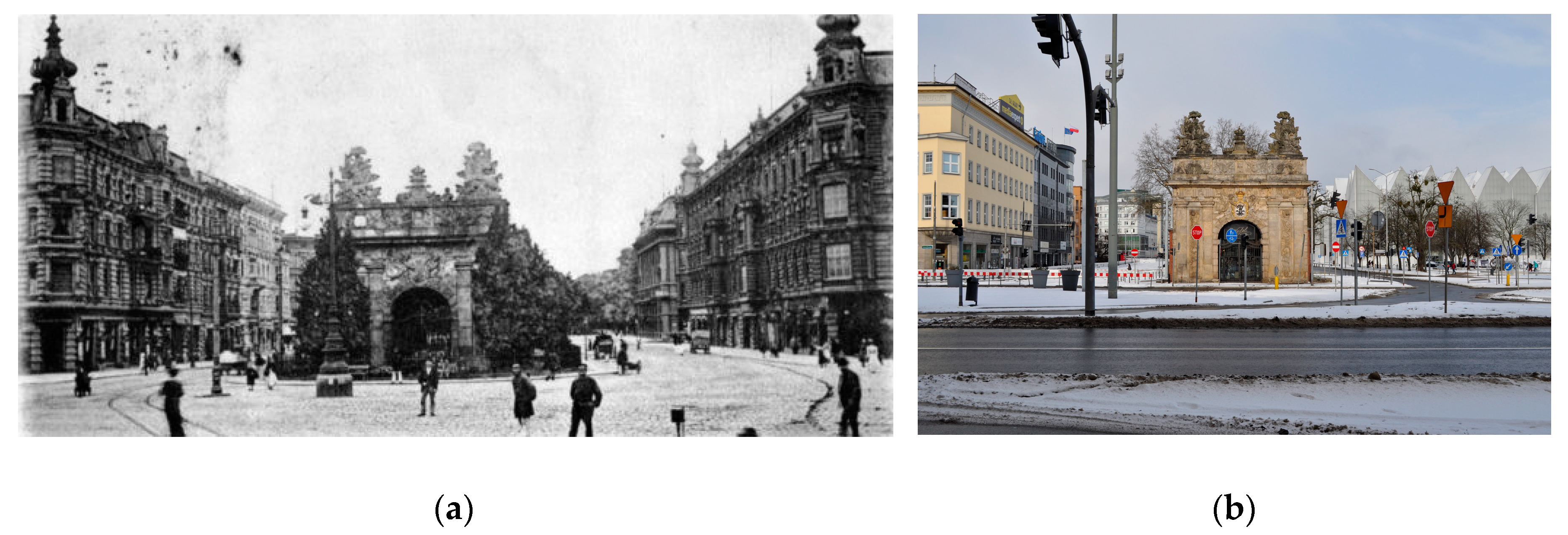
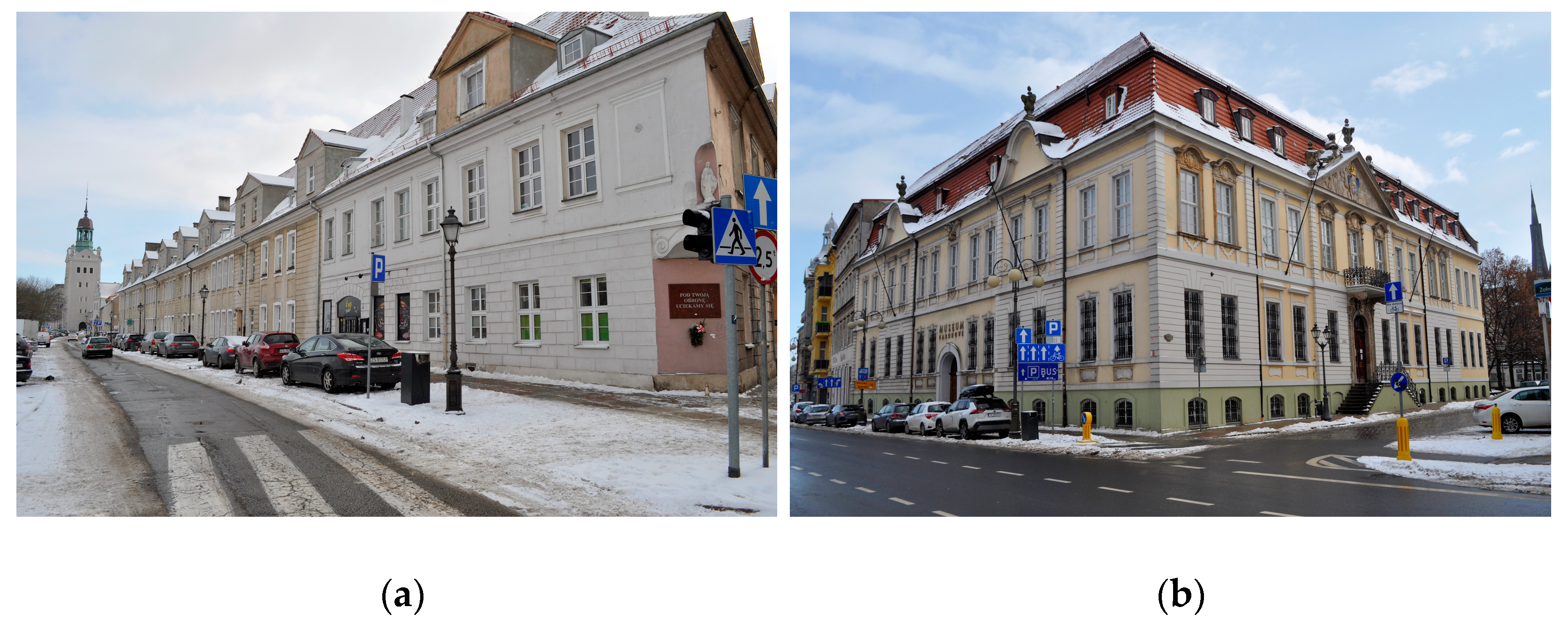

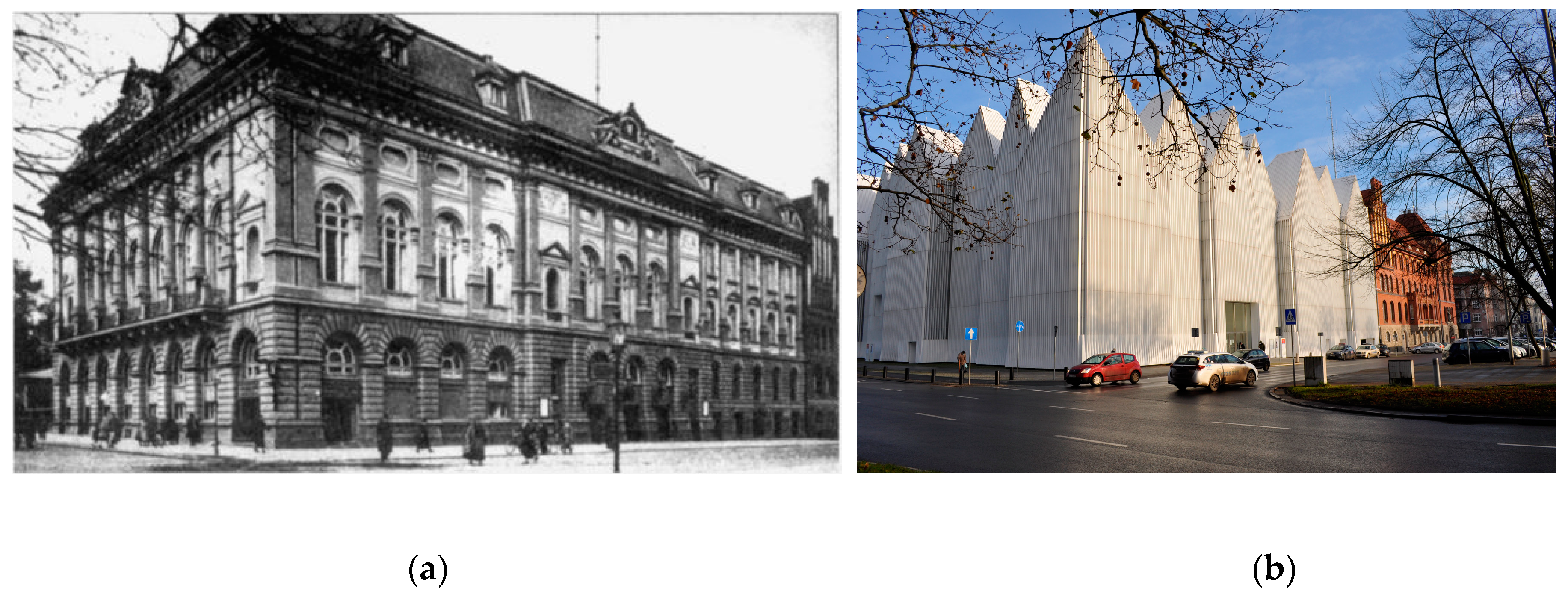
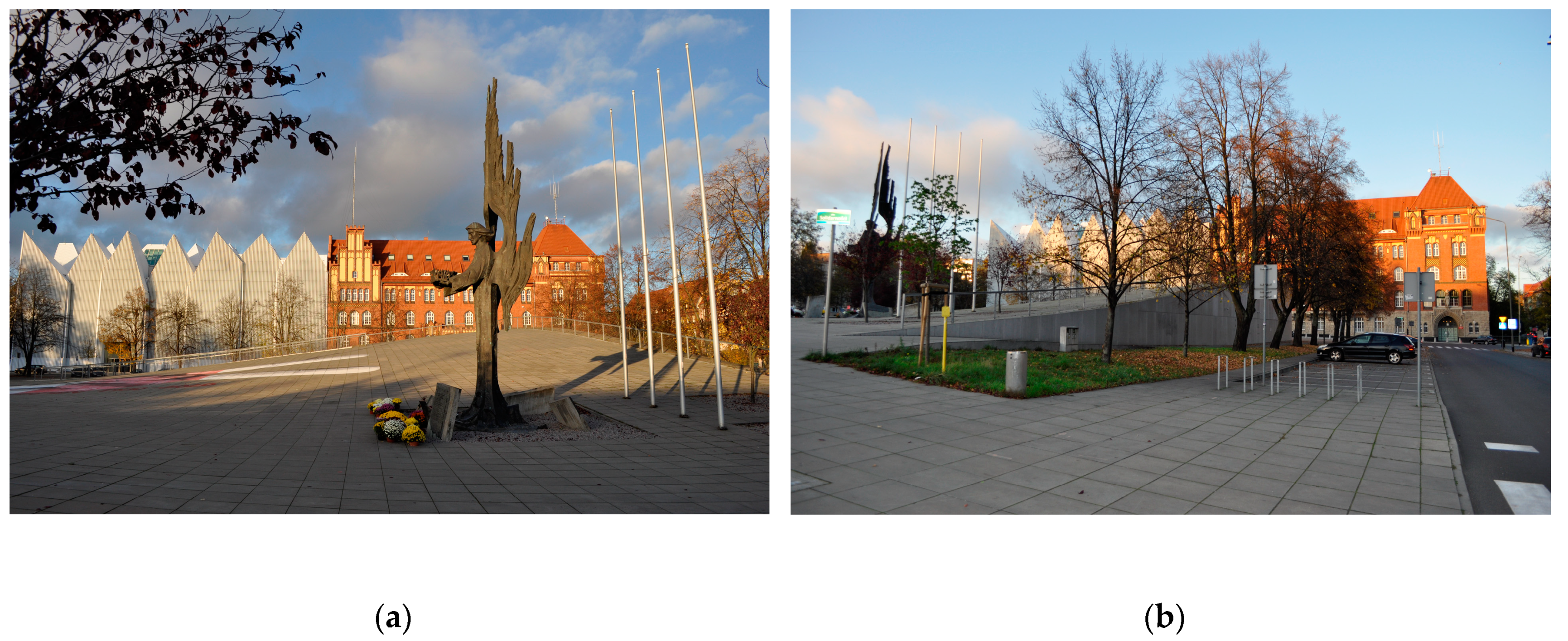


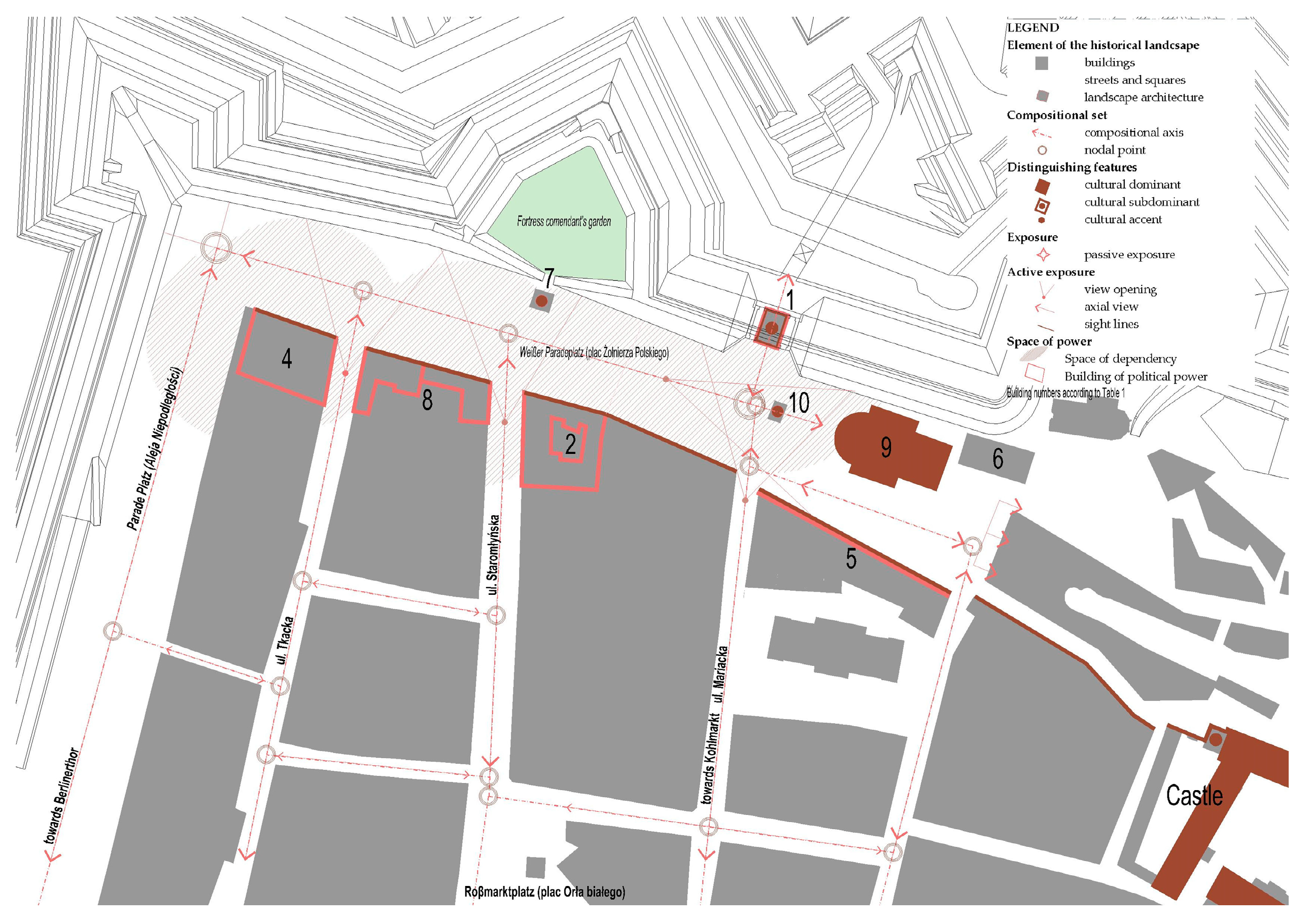


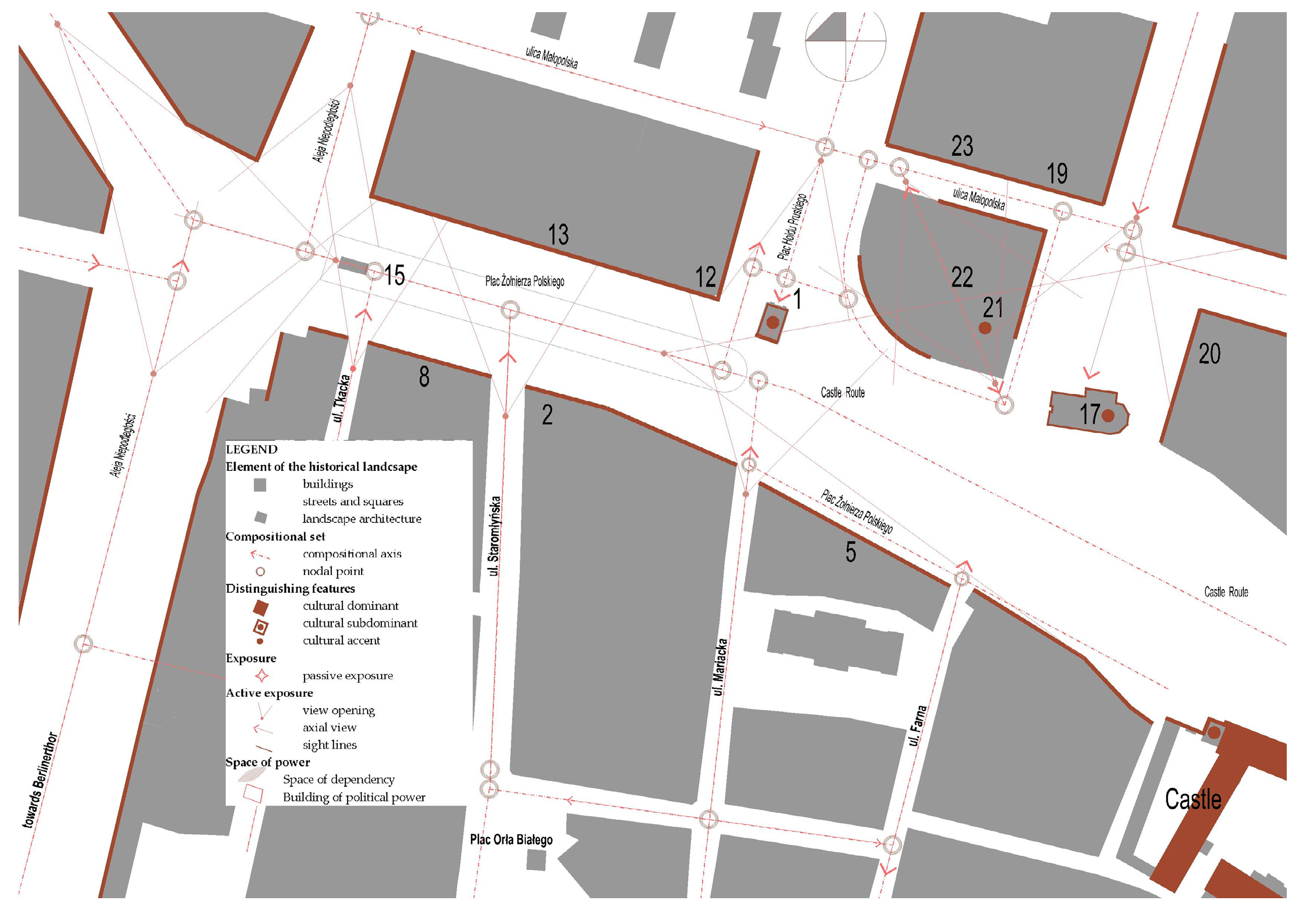
| No. | Building | Data/Reconstruction° Demolition‾ | Architect(s) | Style | Function |
|---|---|---|---|---|---|
| 1 | Plac Żołnierza Polskiego | ||||
| 2 | King’s Gate | 1725–1727/1957° | Gerhard Cornelius Walrave/Bartholome Damart | Dutch baroque classicism | 1994 gallery/2000 café |
| 3 | Landeshaus/Pomeranian State Parliament | 1726–1727/ 1946°1740–1742/ 1964–1969 | Gerhard Cornelius Walrave/Bartholome Damart | Prussian baroque | 1726 1926–1927 museum |
| 4 | Militärkaserne/Neue Baracke | 1727–1729/1903‾ | - | Prussian baroque | military |
| 5 | Professors’ Houses | 1740–1742/1964–1969 | J.F. Freund | Prussian baroque | residential |
| 6 | Landwehr Zeughaus | 1776/1902‾ | - | - | military |
| 7 | Frederick the Great monument | 1793/2008–2011° | Johann Gottfried Schadow | Classicism | landscape architecture |
| 8 | Military headquarters | 1886–1889/ 1957–1958°/ palace 1962–1965°, 1975–1980°/museum | - | Baroque classicism | military/1958 culture 1980 museum |
| 9 | City Theatre | 1846–1849/1954‾ | Carl Ferdinand Langhaus | Classicism | culture |
| 10 | Frederick Wilhelm III monument | 1849/1945‾/2012° | Friedrich Drake | Classicism | landscape architecture |
| 11 | Emperor Wilhelm I monument | 1894/1945‾ | Karl Hilger | Wilhelmine neobaroque | landscape architecture |
| 12 | Haus des Gaupresse/Regional Press House | 1890–1941 | Gustav Gauss | Eclecticism/Neoclassicism | culture/office |
| 13 | Städtische Sparkasse Stettin/City Savings Bank, Regional Committee of the Communist Party, District Court, PKO SA Bank | 1933–35 | Gustav Gauss | Fascist architecture | 1933 bank/ 1945 office/ 1990 bank, court |
| 14 | Mast of s/s Kapitan K. Maciejewicz, monument | 1990/2013‾ | - | - | landscape architecture |
| 15 | Flower Avenue (Aleja Kwiatowa) | 2011–2012 | Pracownia Studio A4 | - | landscape architecture |
| 16 | Plac Solidarności | ||||
| 17 | Church of Sts Peter and Paul | 1223–1237/1425 | - | Gothic style | church |
| 18 | Konzert-und Vereinshaus, Konzerthaus | 1883–1884/1962‾ | Franz Schwechten | Wilhelminian neobaroque | culture, gastronomy |
| 19 | Royal Police Headquarters/Regional Police Headquarters, Security Service | 1902–1905 | Gothic Revivalist | administration | |
| 20 | Pomeranian House | 1924 | Modernism | trading house | |
| 21 | Monument to the December 1970 Victims (Pomnik Ofiar Grudnia 1970) | 2005 | - | landscape architecture | |
| 22 | Dialogue Centre ‘Upheavals’ (DCU) (Centrum Dialogu ‘Przełomy’ (CDP)) | 2009–2013 | Conceptualism | museum | |
| 23 | Mieczysław Karłowicz Philharmonic Orchestra House | 2011–2014 | - | culture | |
Publisher’s Note: MDPI stays neutral with regard to jurisdictional claims in published maps and institutional affiliations. |
© 2021 by the authors. Licensee MDPI, Basel, Switzerland. This article is an open access article distributed under the terms and conditions of the Creative Commons Attribution (CC BY) license (http://creativecommons.org/licenses/by/4.0/).
Share and Cite
Kozłowska, I.; Krasucki, E. Spaces of Dependence and Emancipation in Architectural and Urban Narration, a Case Study: Plac Żołnierza Polskiego and Plac Solidarności in Szczecin. Arts 2021, 10, 19. https://doi.org/10.3390/arts10010019
Kozłowska I, Krasucki E. Spaces of Dependence and Emancipation in Architectural and Urban Narration, a Case Study: Plac Żołnierza Polskiego and Plac Solidarności in Szczecin. Arts. 2021; 10(1):19. https://doi.org/10.3390/arts10010019
Chicago/Turabian StyleKozłowska, Izabela, and Eryk Krasucki. 2021. "Spaces of Dependence and Emancipation in Architectural and Urban Narration, a Case Study: Plac Żołnierza Polskiego and Plac Solidarności in Szczecin" Arts 10, no. 1: 19. https://doi.org/10.3390/arts10010019
APA StyleKozłowska, I., & Krasucki, E. (2021). Spaces of Dependence and Emancipation in Architectural and Urban Narration, a Case Study: Plac Żołnierza Polskiego and Plac Solidarności in Szczecin. Arts, 10(1), 19. https://doi.org/10.3390/arts10010019







